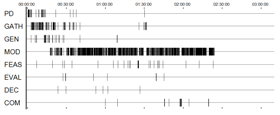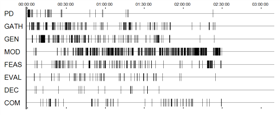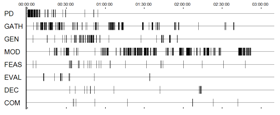Interpretive Tonal Design Soundtracks - Selection Page
| First-Year Engineering Student | Senior Engineering Student | Engineering Expert | |
|---|---|---|---|
| Low Performing |  |
 |
 |
| Average Performing |  |
 |
 |
| High Performing |  |
 |
 |
Sound Mapping
Unblock Flash widget to play samples
Soundtrack Version: Interpretive Tonal
The Interpretive design soundtracks were developed to explore how sound could better be used to show the interaction of the design activities. In particular, we wanted to create separate highlights for three design stages: PD and GATH; GEN, MOD, FEAS, and EVAL; and DEC and COM.
As before, we also added a volume envelope to emphasize early problem scoping activities. By this, we mean that we elevated the volume of any PD and GATH activities within the first 30 minutes of the transcript. The effect of this is that soundtracks without early problem scoping are notably softer.
The main element in the interpretive version is the timbral change applied to GEN, MOD, FEAS and EVAL. An important aspect of the design process is iteration. Although we could not programmatically detect iteration cycles in the transcripts, we used time in task and transitions to approximate iteration. In our implementation, the code keeps a running tally of percent of that activity completed and percent of total activities. So, for a timeline that is primarily MOD, the timbre (the amount of noise) associated with MOD increases greatly in comparison to the other activities. Whereas for someone whose design process involves a more even spead of activities, the sounds remain balanced timbrally.
To highlight DEC and COM, we recognized that they occur rarely and for only short durations. In order to make them stand out, we added a percussive effect to the tones by turning them into notes with clear beginnings and ends. This makes each occurrence sharply distinctive to the ear.
As with all design soundtracks, each activity is piped to either the right or left ear. This separation is noted in the sound samples table to the right.
